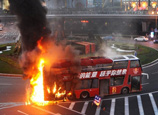
People began to construct the Longmen Grottoes around the time when Emperor Xiaowen of the Northern Wei Dynasty moved the capital to Luoyang (around 495). After construction over several dynasties including the Western Wei, Eastern Wei, Northern Qi, Sui, Tang and the Five Dynasties Period, the one-kilometer-long grottoes remain with more than 2,000 niches for Buddha in caves and more than 100,000 statues were formed. The more than 500-year-old construction process contains the two climatic periods of statues during the Northern Wei Dynasty and the Dawn of Tang Dynasty. Most statues of Buddha preserved in Mount Yi and Mount Que were constructed during these two periods.
Buddhist statues of the Northern Wei Dynasty account for 30 percent and Buddhist statues of the Tang Dynasty account for about 60 percent, and Buddhist statues of other dynasties account for about 10 percent. The large-scale grottoes of the Northern Wei Dynasty mainly include the Guyang Grotto, Binyang Middle Grotto, Lianhua Grotto, Huoshao Grotto, Weizi Grotto, Buddhist Cave Temple, as well as the Putai Grotto and Lu Grotto. Main grottoes of the Tang Dynasty include the Fengxian Grotto, Binyang South Grotto, Binyang North Grotto, Qianxi Temple, Jingshan Temple, Wanfo Grotto, Double Grotto, Huijian Grotto, Leigutai Three Grottoes, Gaoping Governor Grotto, Kanjing Temple, Tangzi Grotto, Ji’nan Grotto, Jingtu Grotto and the Maya Niche for the Three Buddha.
The Guyang Grotto, Binyang Middle Grotto, Lianhua Grotto and Buddhist Cave Temple are the most representative grottoes among the numerous grottoes constructed during the Northern Wei Dynasty. The Guyang Grotto, the earliest cave among the Longmen Grottoes, was constructed by Qiu Huicheng, a clan from the Wei Dynasty on Mount Longmen in the year 495. It concentrated statues of royalty, aristocrats and high-ranking officials after more than 50 years of construction and the mild and amiable postures of Buddha in the Longmen Grottoes were also different from the vigorous and eldritch Yungang Grottoes. The stone carvings represent the style of the Greco-Buddhist art of Gandhara that appeared in Luoyang after grotto art was introduced to Luoyang.


















 Teenage crash victims were talented students
Teenage crash victims were talented students


![]()
